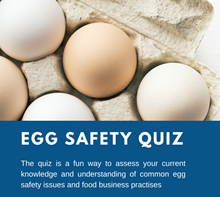Safe handling of raw egg products
Salmonella is the principal microorganism of human health concern associated with the consumption of eggs and egg products. There is a potential risk of illness from consumption of raw or lightly-cooked eggs, or consumption of uncooked foods containing raw egg.
Unhygienic practices used by food handlers during preparation of food containing egg have been reported as contributing factors to the risk of salmonellosis.
It is recommended food businesses consider safer alternatives to using raw eggs, including:
- Using commercially prepared mayonnaise, aioli or similar sauces that contain egg products; or
- Substituting raw egg with pasteurised eggs in foods which are not subject to a pathogen control step. Pasteurised egg products including egg yolks, liquid egg whites and liquid whole eggs are readily available in Western Australia.
If a food business chooses to manufacture products that contain raw eggs, the associated risks must be properly identified and managed, and suitable processing controls implemented.
Products containing raw or lightly cooked eggs*
Several products may contain raw or lightly cooked eggs which include:

- Mayonnaise, aioli and dressings
- egg butter
- raw egg based sauces
- milkshakes/egg nogs
- fried ice cream
- mousses, tiramisu and other desserts containing raw egg.
A food business must ensure that food products containing raw egg either:
- are prepared using pasteurised egg products; or
- implement procedures that ensure the microbial safety of the finished product.
*It should be noted some products that contain raw or lightly cooked egg have little or no history of causing salmonellosis. This includes cooked egg sauces, cakes and soufflés, meringues, icing, marshmallows and frozen desserts. This also applies to some cultural dishes incorporating raw egg such as tartare, congee and soups
Cross contamination considerations
When storing and handling eggs, food businesses must manage risks when handling and preparing other primary products such as raw chicken, meat, seafood and salad ingredients.
Being an animal sourced food, eggs can come into contact with faecal matter during primary production. This microbiological risk and other risks are managed in Standard 4.2.5 of the Australia New Zealand Food Standards Code (the Code) by egg producers and processors.
Standard 2.2.2 of the Code (external site) prohibits the sale of cracked or dirty (unacceptable) eggs. The Standard also requires that eggs are to be individually marked with the producer’s unique identifier (stamp).
When handling and storing eggs, food businesses should:

- Ensure food handlers wash and dry hands before and after handling eggs
- Ensure equipment and food contact surfaces are cleaned and sanitised before and after use
- Store eggs at 5oC (and avoid keeping eggs above 15oC) and minimise the amount of time eggs are kept above 5oC during preparation
- Follow the storage conditions on egg packaging (if present), minimise temperature fluctuations and only take out the number of eggs required for service
- Only using clean and uncracked eggs which are within their use by / best before date coding
- Keep raw eggs separate from ready to eat food
- Minimise contact between the internal components of an egg and the shell, as there is a greater likelihood of Salmonella being found on the exterior of the shell
- When separating the egg yolk from the white, use a sanitised egg separator – not the egg shell or hands
- Store eggs in their original packaging. The packaging ensures that traceability and shelf life information remains with the product
- Not wash eggs prior to use – this could spread microorganisms
How to manage the risks of handling raw eggs
To minimise the risks involved, food businesses should ensure that:
- Customers are able to be informed of whether a product contains raw or lightly cooked eggs so that they can make an informed decision about whether to consume the product
- Any food product manufactured using raw egg is disposed of if it has not been used within 24 hours of manufacture
- Different batches of product are kept in separate containers and are not mixed, including topping up the container with a new batch
- Products containing egg are stored below 5oC at all times or if this is not practical (i.e. during food preparation), use alternative control methods such as recording information detailing the length of time the product has been out of temperature control to demonstrate compliance with the 2 hour/4 hour rule (Appendix 2 of Safe Food Australia) (external site)
- Sauces and dressings containing raw eggs should have a pH of 4.2 or less. The acid present in vinegar or lemon juice will lower the pH which inhibits or slows the growth of bacteria present, but it will not kill bacteria (Appendix 3 of Safe Food Australia) (external site). pH can be checked using a pH meter or pH paper
This information is also summarised in the safe handing of eggs and products containing eggs factsheet (PDF 100KB)
Egg safety quiz - test your knowledge

The Egg Safety Quiz is a fun way to assess your current knowledge and understanding of common egg safety issues and food business practices.
The survey will take no longer than 5 minutes to complete. You will be provided your score afterwards. Your responses are confidential.
Complete the Egg Safety Quiz here (external site).
Last reviewed: 03-03-2021
Produced by
Environmental Health Directorate